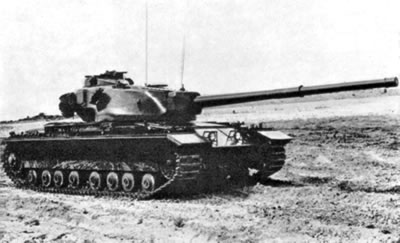The FV214 Conqueror heavy tank was supposed to have been a match for the Soviet Union’s JS-3 heavy tank. The Conqueror did not remain in service for very long.
In 1944, Great Britain started working on the development of an infantry tank known as the A45. This tank was supposed to be a universal tank, with one hull that could be used in many different ways – for example, as an amphibious tank, a flamethrower or a dozer.
The A45 was supposed to support the tank that was to become the A41 Centurion main battle tank, which was also in development.
After World War II ended, the new universal tank was designated the FV200 series.

The first prototype of the FV200 series was completed in 1948. It used the turret from the A41 Centurion and had a 17 pounder main gun.
In 1949, the British decided that the Centurion could perform many of the roles that were planned for the Universal Tank, so development of the Universal Tank was halted.
However, Britain needed a heavy tank that could compete with the JS-3. A new heavy tank, which used the FV201’s chassis and the Centurion’s turret, was built.
During trials, this new heavy tank was known as the FV221 Caernarvon.
The first prototype of this new tank, which eventually was designated the FV214 Conqueror, was finished in 1950.
Production began in 1956.
The Conqueror weighs 63 tons (66,044 kg) and has a maximum armor thickness of 7.01 inches (178mm) thick.
It has a Horstmann suspension, which consists of four units on each side of the tank. Each unit has two road wheels.
There are four track return rollers.
The idler is at the front and the drive sprocket is at the rear.
Main armament on the FV 214 Conqueror heavy tank is a 4.72 inch (120mm) gun. Secondary armament consists of two 0.3 inch (7.62mm) machine guns – one coaxial and one on the commander’s cupola – and six pairs of smoke dischargers.
A four man crew, consisting of driver, commander, gunner and loader, operates the FV214. The driver sits in the front of the hull on the right. Some ammunition is stored on his left. The commander, gunner and loader sit in the turret.
A fireproof bulkhead separates the fighting compartment from the engine and transmission, which are located in the back of the hull.
The FV214 Conqueror heavy tank was hard to maintain. There were problems with its electrical system. Because it was so heavy, it was difficult to maneuver and could not cross some bridges
Conqueror heavy tanks were issued to armored regiments in West Germany. They were designed to provide the Centurion with long-range anti-tank support.
The Conqueror was never used outside of West Germany and never saw combat.
Variants of the FV214 included a self-propelled anti-tank gun and an armored recovery vehicle.
Production of the Conqueror heavy tank ended in 1959, and the Conqueror was taken out of service in 1966. Fewer than 200 FV214 Conqueror heavy tanks were built.
FV214 Conqueror Heavy |
|
|---|---|
| Active: | 1956 |
| Crew: | 4 |
| Weight: | 63 tons (64,044kg) |
| Length: | 25ft 3in (7.7m), 37 ft 11 in (11.6m) with gun forwards |
| Height: | 10ft 11in (3.35m) |
| Width: | 13ft (3.99m) |
| Weapons: | Main – 4.72in (120mm) gun, Secondary – 2 x 0.in (7.62mm) machine guns (1 coaxial, 1 on commander’s cupola), six pairs of smoke dischargers |
| Armor | Maximum – 7.01in (178mm) |
| Engine: | Rolls Royce Meteor M120 Mark 1A 12-cylinder gasoline, 810hp |
| Speed: | 21 mph (34 kmh) |
| Range: | 95 miles (153 km) |